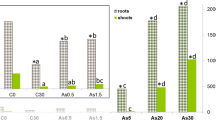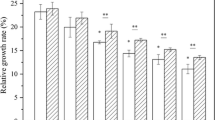Abstract
Metabolic responses to hexavalent chromium (Cr6+) stress and the uptake and translocation of Cr6+ were investigated using pre-rooted hybrid willows (Salix matsudana Koidz × Salix alba L.) exposed to hydroponic solution spiked with K2CrO4 at 24.0 ± 1°C for 192 h. Various physiological parameters of the plants were monitored to determine toxicity from Cr6+ exposure. At Cr6+ treatments of ≤2.1 mg Cr/l, the transpiration rate of plants was > 50% higher than that of the non-treated control plants. As Cr concentrations were increased further, a slight increase in the transpiration rate was also observed compared with the controls. Negligible difference in the chlorophyll contents in leaves between the treated and the non-treated control plants was measured, except for willows exposed to 1.05 mg Cr/l. The response of soluble proteins in leaves of willows to Cr treatments was remarkable. Cr-induced toxicity appeared in all treatments resulting in reduced activities of catalase (CAT) and peroxidase (POD) compared to the controls. Superoxide dismutases (SOD) activity in the leaf cells showed a positive increase after Cr exposure. Of all selected parameters, soluble proteins in leaves were the most sensitive to Cr6+ doses, showing a significant linear correlation negatively (R 2 = 0.931). Uptake of Cr6+ by willows grown in flasks was found to increase linearly with the added Cr6+ (a zero order kinetics), as indicated by the high R 2 (0.9322). Recovery of Cr in different parts of plant materials varied significantly with roots being the dominant site of Cr accumulation. Although the translocation to shoots was detected, the amount of Cr translocated to shoots was considerably small. The capacity of willows to assimilate Cr6+ was also evaluated using detached leaves and roots in sealed glass vessels in vivo. Uptake of Cr by roots was mediated possibly through an active transport mechanism, whereas the cuticle of leaves was the major obstacle to uptake Cr from the hydroponic solution. In addition, both cysteine and ascorbic acid showed a remarkable potential to reduce Cr6+ at a neutral pH. Results indicated that the added Cr did not cause deleterious effects on plant physiological functions over a 192-h period of exposure. Significant removal of Cr from the hydroponic solution was observed in the presence of hybrid willows. The data also suggest that phytoremediation of Cr6+ is possible and ecologically safe due to the minor translocation of Cr to aerial tissues.



Similar content being viewed by others
References
Aldrich MV, Gardea-Torresdey JL, Peralta-Videa JR, Parsons JG (2003) Uptake and reduction of Cr(VI) to Cr(III) by mesquite (Prosopis spp.): Chromate–plant interaction in hydroponics and solid media studied using XAS. Environ Sci Technol 37:1859–1864
Banks MK, Schwab AP, Henderson C (2006) Leaching and reduction of chromium in soil as affected by soil organic content and plants. Chemosphere 62:255–264
Barcelo J, Poschenrieder C, Gunse B (1985) Effects of chromium (VI) on mineral element composition of bush beans. Plant Nutr 8:211–217
Bartlett RJ, James BR (1988) Mobility and bioavailability of chromium in soils. In: Nriagu JO, Nieboer E (eds) Chromium in the Natural and Human Environments. Wiley, New York, pp. 267–383
Bolan NS, Adriano DC, Natesan R, Koo BJ (2003) Effects of organic amendments on the reduction and phytoavailability of chromate in mineral soil. J Environ Qual 32:120–128
Bonet A, Poschenrieder C, Barcelo J (1991) Chromium III-ion interactions in Fe-deficient and Fe-sufficient bean plants. I. Growth and nutrient content. J Plant Nutr 14:403–414
Boonyapookana B, Upatham S, Kruatrachue M, Pokethitiyook P, Singhakaew S (2002) Phytoaccumulation and phytotoxicity of cadmium and chromium in duckweed Wolffia globosa. Int J Phytoremed 4:87–100
Chatterjee J, Chatterjee C (2000) Phytotoxicity of cobalt, chromium and copper in cauliflower. Environ Pollut 109:69–74
Cheung KH, Gu JD (2005) Chromate reduction by Bacillus megaterium TKW3 isolated from marine sediments. World J Micro Biotechnol 21:213–219
Dixit V, Pandey V, Shyam R (2002) Chromium ions inactivate electron transport and enhance superoxide generation in vivo in pea (Pisum sativum L.cv. Azad) root mitochondria. Plant Cell Environ 25:687–693
Fridovich I (1978) The biology of oxygen radical. Science 39:522–526
Gad CS (1989) Acute and chronic systemic chromium toxicity. Sci Tot Environ 86:149–157
Greger M (1999) Metal availability, uptake, transport and accumulation in plants. In: Prasad MNV, Hagemeyer J (eds) Heavy metal stress in plants: from molecules to ecosystems, Springer-Verlag. Berlin, Heidelberg, New York. pp 51–57
Gwozdz EA, Przymusinski R, Rucinska R, Deckert J (1997). Plant cell responses to heavy metals: molecular and physiological aspects. Acta Physiol Plant 19:459–65
Halliwell B, Gutteridge JMC (1984) Oxygen toxicity, oxygen radicals, transition metals and disease. Biochem J 219:1–14
Hauschild MZ (1993) Putrescine (1,4-diaminobutane) as an indicator of pollution-induced stress in higher plants: barley and rape stressed with Cr(III) or Cr(VI). Ecotoxicol Environ Saf 26:228–247
Han FX, Banin A, Su Y, Monts DL, Plodinec MJ, Kingery WL, Triplett GB (2002) Industrial age anthropogenic inputs of heavy metals into the pedosphere. Naturwissenschaften 89:497–504
Hunter JG, Vergnano O (1953) Trace element toxicities in oat plants. Ann Appl Biol 4:761–777
Jain R, Srivastava S, Madan VK, Jain R (2000) Influence of chromium on growth and cell division of sugarcane. Indian J Plant Physiol 5:228–31
James BR, Bartlett RJ (1984) Plant soil interaction of chromium. J Environ Qual 13:67–70
Jin JH, Ding ZR (1981) Methods of plants biochemistry analysis. Beijing: Chinese Science Press, China
Khan AG (2001) Relationships between chromium biomagnification ratio, accumulation factor, and mycorrhizae in plants growing on tannery effluent-polluted soil. Envinon Int 26:417–423
Kimbrough DE, Cohen Y, Winer AM, Creelam L, Mabuni C (1999) A critical assessment of chromium in the environment. Crit Rev Environ Sci Technol 29:1–46
Kumar PBAN, Dushenkov V, Motto H, Raskin I (1995) Phytoextraction: the use of plants to remove heavy metals from soils. Environ Sci Technol 29:1232–1238
Lee KP, Ulrich CE, Geil RG, Trochimowicz HJ (1989) Inhalation toxicity of chromium dioxide dust to rats after two years exposure. Sci Tot Environ 86:83–108
Losi ME, Amrhein C, Frankenberger ET Jr (1994) Environmental biochemistry of chromium. Rev Environ Contam Toxicol 136:91–121
Lytle CM, Lytle FW, Yang N, Qian J, Hansem D, Zayed A, Terry N (1998) Reduction of Cr(VI) to Cr(III) by wetland plants: potential for in situ heavy metals detoxification. Environ Sci Technol 32:3087–3093
Maclachalam S, Zalik S (1963) Plastid structure, chlorophyll concentration and free amino acid composition of a chlorophyll mutant of barley. Can J Bot 41:1053–1062
Prasad MNV (1998) Metal-biomolecule complexes in plants: occurrence, functions and applications. Analusis 26:25–28
Rai UN, Tripathi RD, Kumar N (1992) Bioaccumulation of chromium and toxicity on growth, photosynthetic pigments, photosynthesis in vivo nitrate reductase activity and protein content in a chlorococcalean green alga Glaucocystis nostochinearum Itzigsohn. Chemosphere 25:721–732
Raskin I, Kumar PBAN, Dushenkov S, Salt D (1994) Bioconcentration of heavy metals by plants. Curr Opin Biotechnol 28:115–126
Sachs L (1992) Angewandte Statistik. Springer, Berlin, Germany
Salt DE, Smith RD, Raskin I (1998) Phytoremediation. Ann Rev Plant Physiol Plant Mol Biol 49:643–668
Schönherr J, Riederer M (1989). Foliar penetration and accumulation of organic chemicals in plant cuticles. Rev Environ Contam Toxicol 108:1–70
Scoccianti V, Crinelli R, Tirillini B, Mancinelli V, Speranza A (2006) Uptake and toxicity of Cr (Cr3+) in celery seedlings. Chemosphere 64:1695–1703
Sen AK, Mondal NG, Mandal S (1994) Toxic effects of chromium (VI) on the plant Salvinia natans L. Environ Ecol 12:279–83
Shahandeh H, Hossner LR (2000) Plant screening for chromium phytoremediation. Int J Phytoremed 2:31–51
Shanker AK, Cervantes C, Loza-Tavera H, Avudainayagam S (2005) Chromium toxicity in plants. Environ Int 31:739–753
Sharma DC, Sharma CP (1996) Chromium uptake and toxicity effects on growth and metabolic activities in wheat, Triticum aestivum L. cv. UP 2003. Indian J Exp Biol 34:689–691
Sharma DC, Sharma CP, Tripathi RD (2003) Phytotoxic lesions of chromium in maize. Chemosphere 51:63–68
Srivastava S, Prakash S, Srivatava MM (1999) Chromium mobilization and plant availability—the impact of organic complexing ligands. Plant Soil 212:203–208
Trapp S, Zambrano KC, Kusk KO, Karlson U (2000) A phytotoxicity test using transpiration of willows. Arch Environ Contam Toxicol 39:154–160
Tsang E, Bowler C, Herouart D, Villarroel R, Genetello C, Inze D (1991) Differential regulation of superoxide dismutases in plants exposed to environmental stress. Plant Cell 3:783 –792
Vajpayee P, Tripathi RD, Rai UN, Ali MB, Singh SN (2000) Chromium accumulation reduces chlorophyll biosynthesis, nitrate reductase activity and protein content in Nympaea alba L. Chemosphere 41:1075–1082
Wallace A, Soufi SM, Cha JW, Romney EM (1976) Some effects of chromium toxicity on bush bean plants grown in soil. Plant Soil 44:471–473
Xu XR, Li HB, Gu JD, Li XY (2005) Kinetics of the reduction of chromium (VI) by vitamin C. Environ Toxicol Chem 24:1310–1314
Ying Q (2002) Phytoremediation: modeling plant uptake and contaminant transport in the soil-plant-atmosphere continuum. J Hydrol 266:66–82
Yu XZ, Trapp S, Zhou PH, Peng XY, Cao X (2006) Response of weeping willows to linear alkylbenzene sulfonate. Chemosphere 64:43–48
Zayed AM, Lytle CM, Qian JH, Terry N (1998) Chromium accumulation, translocation and chemical speciation in vegetable crops. Planta 206:293–299
Zayed AM, Terry N (2003) Chromium in environment: factors affecting biological remediation. Plant soil 249:135–156
Zeid IM (2001) Response of Phaseolus vulgaris to chromium and cobalt treatments. Biol Plant 44:111–115
Acknowledgements
This work was supported by a Ph.D. studentship from The University of Hong Kong. Thanks to Luan Li and Shuo Liu for their technical assistance.
Author information
Authors and Affiliations
Corresponding author
Rights and permissions
About this article
Cite this article
Yu, XZ., Gu, JD. & Huang, SZ. Hexavalent chromium induced stress and metabolic responses in hybrid willows. Ecotoxicology 16, 299–309 (2007). https://doi.org/10.1007/s10646-006-0129-6
Received:
Accepted:
Published:
Issue Date:
DOI: https://doi.org/10.1007/s10646-006-0129-6




